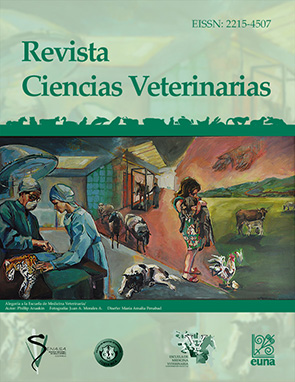Behaviour of the Varroa destructor mite in worker brood cells of Africanized honey bees (Apis mellifera)
DOI:
https://doi.org/10.15359/rcv.35-2.5Keywords:
Varroa destructor, behavior, feeding, defecation, reproductionAbstract
The behaviour of the Varroa destructor mite was studied in worker brood cells of Africanized honey bees. Four colonies located in Barreal de Heredia were used. Two of the colonies were selected to allow the queen to lay eggs in the artificial cells, while the other two were used to collect adult mites. Once the cell is sealed, it is artificially infested with a mite and placed in an incubator with controled temperature and humidity. The larva as well as the mite’s activities within the cell are observed and recorded using a micro-camera, which sends the signal to long-duration recording equipment. Parameters evaluated for each mite include feeding and defecation behavior, periods of inactivity, and reproductive analysis. The feeding behavior of the V. destructor mite varied between the larval and pupal stages. The varroa mite fed 6.5 times per day during the larval stage and showed no preference for a feeding site, while it fed 3.4 times per day during the pupal stage and used a particular feeding site. It is determined that the varroa mite shows a preference for defecation during the first days of observation. Most of the infested cells have one fecal accumulation site of 0.3 mm diameter in the posterior part of the cell and it was the favorite resting site for the mite, where it spent 67.1 min per day (n = 20). Longitudinal displacements were observed in 25.0% (n = 28) of the analyzed bee larva. Turning movements around the cell, from the bottom to the top, were carried out by these larva, with a total time of 874.9 ± 262.2 min per day (n = 7). Most of the mites analyzed did not reproduce (85.7%) and those that did produced mainly immature brood (10.7%).References
Anderson, D. 2000. Variation in the parasitic bee mite Varroa jacobsoni Oud. Apidologie 31: 281–292. https://doi.org/10.1051/apido:2000122
Anderson, D. & Trueman, J. 2000. Varroa jacobsoni (Acari: Varroidae) is more than one species. Exp. Appl. Acarol. 24: 165–189. https://doi.org/10.1023/A:1006456720416
Aumeier, P. 2001. Bioassay for grooming effectiveness towards Varroa destructor mites in Africanized and Carniolan honey bees. Apidologie 32: 81-90. https://doi.org/10.1051/apido:2001113
Bailey, L. & Ball, B. 1991. Honey bee pathology. Second Edition. Academic Press, London, UK. 193 pp.
Ball, B. 1996. Honey bee viruses: a cause for concern. Bee World 77 (3): 117-119. https://doi.org/10.1080/0005772X.1996.11099302
Boecking, O. & Spivak, M. 1999. Behavioural defenses of honey bees against Varroa jacobsoni Oud. Apidologie 30: 141–158. https://doi.org/10.1051/apido:19990205
Boecking, O. & Ritter, W. 1993. Grooming and removal behavior of Apis mellifera intermissa in Tunisia against Varroa jacobsoni. J. Apic. Res. 32: 127–134. https://doi.org/10.1080/00218839.1993.11101297
Calderón, R., Arce, H. & van Veen, J. 1998. Varroosis: situación actual del ácaro en Costa Rica. Memorias del XI Congreso Nacional de Medicina Veterinaria. 97 p.
Calderón, R., Zamora, L. & Veen, J. 2007. The reproductive rate of Varroa destructor in drone brood of Africanized honey bees. J. Apic. Res. 46: 140–143. https://doi.org/10.1080/00218839.2007.11101384
De Jong, D. 1997. Varroa and other parasites of brood. In: R. Morse. y K. Flotum. Honey bee pests, predators, and diseases. 3er Ed. AI Root Co. Ohio, United States of America. 280-327 p.
Donzé, G. & Guerin, P. 1994. Behavioral attributes and parental care of varroa mites parasiting honeybee brood. Behav. Ecol. Sociobiol. 34: 305-319. https://doi.org/10.1007/BF00197001
Donzé, G. & Guerin, P. 1997. Time-activity budgets and spacing structure by the different life stages of Varroa jacobsoni in capped brood of the honey bee, Apis mellifera. J. Insect Behav. 10: 371-393. https://doi.org/10.1007/BF02765605
Donzé, G., Fluri, P. & Imdorf, A. 1998. A Look under the Cap: The Reproductive Behavior of Varroa in the Capped Brood of the Honey Bee. Am. Bee J. 138: 528-533.
Erickson, E. 1996. Fecal accumulations deposited by Varroa can be used a simple field diagnostic for infestations of this honey bee parasite. Am. Bee J. 136 (1): 63-64.
Fuchs, S. 1992. Choice in Varroa jacobsoni Oud. between honey bee, drone or worker brood cells for reproduction. Behav. Ecol. Sociobiol. 31: 429-435. https://doi.org/10.1007/BF00170610
Fuchs, S. & Langenbach, K. 1989. Multiple infestations of Apis mellifera L. brood cells and reproduction in Varroa jacobsoni Oud. Apidologie 20: 257-266. https://doi.org/10.1051/apido:19890308
Guzmán-Novoa, E., Vandame, R. & Arechavaleta M. 1999. Susceptibility of European and Africanized honey bees (Apis mellifera L.) to Varroa jacobsoni Oud. in México. Apidologie 30: 173–182. https://doi.org/10.1051/apido:19990207
Harris, J. & Harbo, J. 1999. Low sperm counts and reduced fecundity of mites in colonies of honey bee (Hymenoptera: Apidae) resistant to Varroa jacobsoni (Mesostigmata: Varroidae). J. Econ. Entomol. 92: 83-90. https://doi.org/10.1093/jee/92.1.83
Herrmann, M., Kanbar, G. & Engels, W. 2005. Survival of honey bee (Apis mellifera) pupae after trypan blue staining of wounds caused by Varroa destructor mites or artificial perforation. Apidologie 36: 107-111. https://doi.org/10.1051/apido:2004074
Hung, A., Adams, J. & Shimanuki, H. 1995. Bee parasitic mite syndrome (II): the role of varroa mite and viruses. Am. Bee J. 135: 702-704.
Ibrahim, A. & Spivak, M. 2005. The relationship between hygienic behaviour and suppression of mite reproduction as honey bee (Apis mellifera) mechanisms of resistance to Varroa destructor. Apidologie 37: 31-40. https://doi.org/10.1051/apido:2005052
Ifantidis, M. & Rosenkranz, P. 1988. Reproduktion der Bienenmilbe Varroa jacobsoni (Acarina: Varroidae). Entomol. Genet. 14: 111-122. https://doi.org/10.1127/entom.gen/14/1988/111
Kanbar, G. & Engels, W. 2004a. Visualisation by vital staining with trypan blue of wounds punctured by Varroa destructor mites in pupae of the honey bee (Apis mellifera). Apidologie 35: 25-29. https://doi.org/10.1051/apido:2003057
Kanbar, G. & Engels, W. 2004b. Number and position of wounds on honey bee (Apis mellifera) pupae infested by a single Varroa mite. Eur. J. Entomol. 101: 323-326. https://doi.org/10.14411/eje.2004.041
Martin, S. 1995. Reproduction of Varroa jacobsoni in cells of Apis mellifera containing one or more mother mites and the distribution of these cells. J. Apic. Res. 34: 187-196. https://doi.org/10.1080/00218839.1995.11100904
Martin, S. & Kemp, D. 1997. Average number of reproductive cycles performed by Varroa jacobsoni in honey bee (Apis mellifera) colonies. J. Apic. Res. 36: 113-123. https://doi.org/10.1080/00218839.1997.11100937
Martin, S., Holland, K. & Murray, M. 1997. Non-reproduction in the honeybee mite Varroa jacobsoni. Exp. Appl. Acarol. 21: 539-549. https://doi.org/10.1023/A:1018492231639
Martin, S. & Medina, L. 2004. Africanized honeybees have a unique tolerance to varroa mites. Trends Parasitol. 20: 112-114. https://doi.org/10.1016/j.pt.2004.01.001
Rath, W. & Drescher, W. 1990. Response of Apis cerana Fabri. towards brood infested with Varroa jacobsoni (Oudemans) and infestation rate of colonies in Thailand. Apidologie 21: 311-321. https://doi.org/10.1051/apido:19900406
Rosenkranz, P. 1999. Honey bee (Apis mellifera L.) tolerance to Varroa jacobsoni Oud. in South America. Apidologie 30: 159-172. https://doi.org/10.1051/apido:19990206
Shimanuki, H., Knox, D. & De Jong, D. 1992. The influence of brood comb cell size on the reproductive behavior of the ectoparasitic mite Varroa destructor in Africanized honey bee colonies. Genet. Mol. Res. 2: 36-42.
Spivak, M. & Gilliam, M. 1998. Hygienic behavior of honey bees and its application for control of brood diseases and Varroa. Bee World 79(4): 169-186. https://doi.org/10.1080/0005772X.1998.11099408
Van Veen, J., Calderón, R., Cubero, A. & Arce, H. 1998. Varroa jacobsoni Oudemans in Costa Rica: detection, spread and treatment with formic acid. Bee World 79: 115-116. https://doi.org/10.1080/0005772X.1998.11099370
Downloads
Published
How to Cite
Issue
Section
License
Licensing of articles
All articles will be published under a license:

Licencia Creative Commons Atribución-NoComercial-SinDerivadas 3.0 Costa Rica.
Access to this journal is free of charge, only the article and the journal must be cited in full.
Intellectual property rights belong to the author. Once the article has been accepted for publication, the author assigns the reproduction rights to the Journal.
Ciencias Veterinarias Journal authorizes the printing of articles and photocopies for personal use. Also, the use for educational purposes is encouraged. Especially: institutions may create links to specific articles found in the journal's server in order to make up course packages, seminars or as instructional material.
The author may place a copy of the final version on his or her server, although it is recommended that a link be maintained to the journal's server where the original article is located.
Intellectual property violations are the responsibility of the author. The company or institution that provides access to the contents, either because it acts only as a transmitter of information (for example, Internet access providers) or because it offers public server services, is not responsible.







